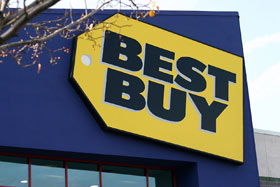 Last holiday season Best Buy had a problem. In the fourth quarter of 2012 the company reported a loss over $1.5 billion dollars. That was compared to a net income of $651 million in the crucial fourth quarter of 2011. The root of the problem for Best Buy and other brick and mortar big box stores like it, is show rooming.
Last holiday season Best Buy had a problem. In the fourth quarter of 2012 the company reported a loss over $1.5 billion dollars. That was compared to a net income of $651 million in the crucial fourth quarter of 2011. The root of the problem for Best Buy and other brick and mortar big box stores like it, is show rooming.
For those that don’t speak retail, show rooming is when customers use a brick and mortar retailer to pick up, touch and try out the latest products and then turn around and purchase them at an online outlet like Best Buy or Amazon. Brick and mortar retailers can’t usually compete with sales from online retailers who’s margins are much bigger.
Leading up and through the 2012 holiday season many analysts were predicting the fall of the brick and mortar retailer. Rising expenses and shrinking margins would give way to purchasing things online. Easy to use mobile apps, incentivized buying clubs like Amazon prime and quickness of the online purchase were more driving factors to why consumers were shifting.
Best Buy decided this year that they needed to do something and do it quick.
“What a difference a year makes. … The press couldn’t have been more negative about what was going to happen to Best Buy this time last year,” said Scott Moore, senior VP-marketing told AdAge. “At the root of it there was a theme around how showrooming would be the final straw, the thing that just knocked us out.”
So to combat showrooming Best Buy went head to head with it and Best Buy spent millions of dollars coming up with an advertising campaign that invited shoppers into their giant neighborhood showrooms. Once the shoppers arrived it would be the task of the Best Buy blue shirts to turn that foot traffic into actual sales. Best Buy started offering price matching, even with online competitors, to help with those conversions.
Best Buy recruited LL Cool J, Jason Schwartzman, Maya Rudolph and Will Arnett to help bolster the campaign.
The actual sales results won’t be known until Best Buy reports their fourth quarter however it looks like it may have worked. In the 3rd quarter the retailer saw an increase of 0.3% up from a deficit of 5.1% the previous year. In the third quarter Best Buy saw a 16 cent increase this year as opposed to year ago loss of 3 cents.
AdAge reported on research from social media analytics firm Crimson Hexagon. The firm analyzed Twitter and Facebook data from 16.500 online consumers from October 12th to December 12th on Best Buy and their showrooming campaign. The firm reported that the consumer sentiment was far more positive than negative in regards to the commercials themselves. However, the data about the actual initiative in the campaign may not have been so good for Best Buy.
“They’re [consumers are] telling us that Best Buy is where they go to look at merchandise and then they go buy it online later,” Jehan. Hamedi a Global Market Development Manager at Crimson Hexagon told AdAge. “What consumers are not shy about telling us is why they showroom, when they do it and the connection to a named competitor, and that’s Amazon.”
Hamedi went on to highlight a specific Tweet during the period from @NickSilicon “Dear Best Buy, I’m glad you know your place as a showroom. Love, Everyone who shops at Amazon.”
Hamedi offered up suggestions to Best Buy to make the in-store experience more interactive and memorable, something Verizon Wireless is starting to do at their new big box stores.
What was more disturbing was that only 1% of the respondents said embracing showrooming is a good move.
The echoing theme throughout retail and tech circles is that there is more than just price that drives people to purchase online. On the other hand, as Crimson Hexagon and other’s research has shown, there is most to just shopping when it comes to going into a Big Box store.
Some people feel that buying big ticket items can be hampered by the company you’re with on the shopping excursion. For instance, off line shopping isn’t a solo destination and with everyone as busy as they are these days it’s harder and harder to get an offline shopping trip coordinated with the right people. Days of mom and dad going to the big box store while the kids are at a sitter are over. Since many families go into Best Buy together some of those purchases can’t be made with the kids at the store. Then, by the time a consumer gets home to do the online shopping, a price deal or Amazon’s Prime service may tip the scales in Amazon’s favor.
It appears that Best Buy has at least started to take some of it’s market share back. Time will tell just how much.

